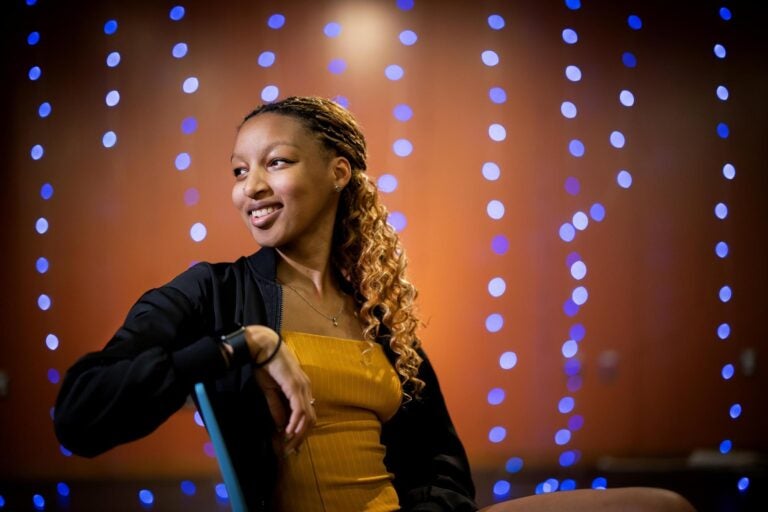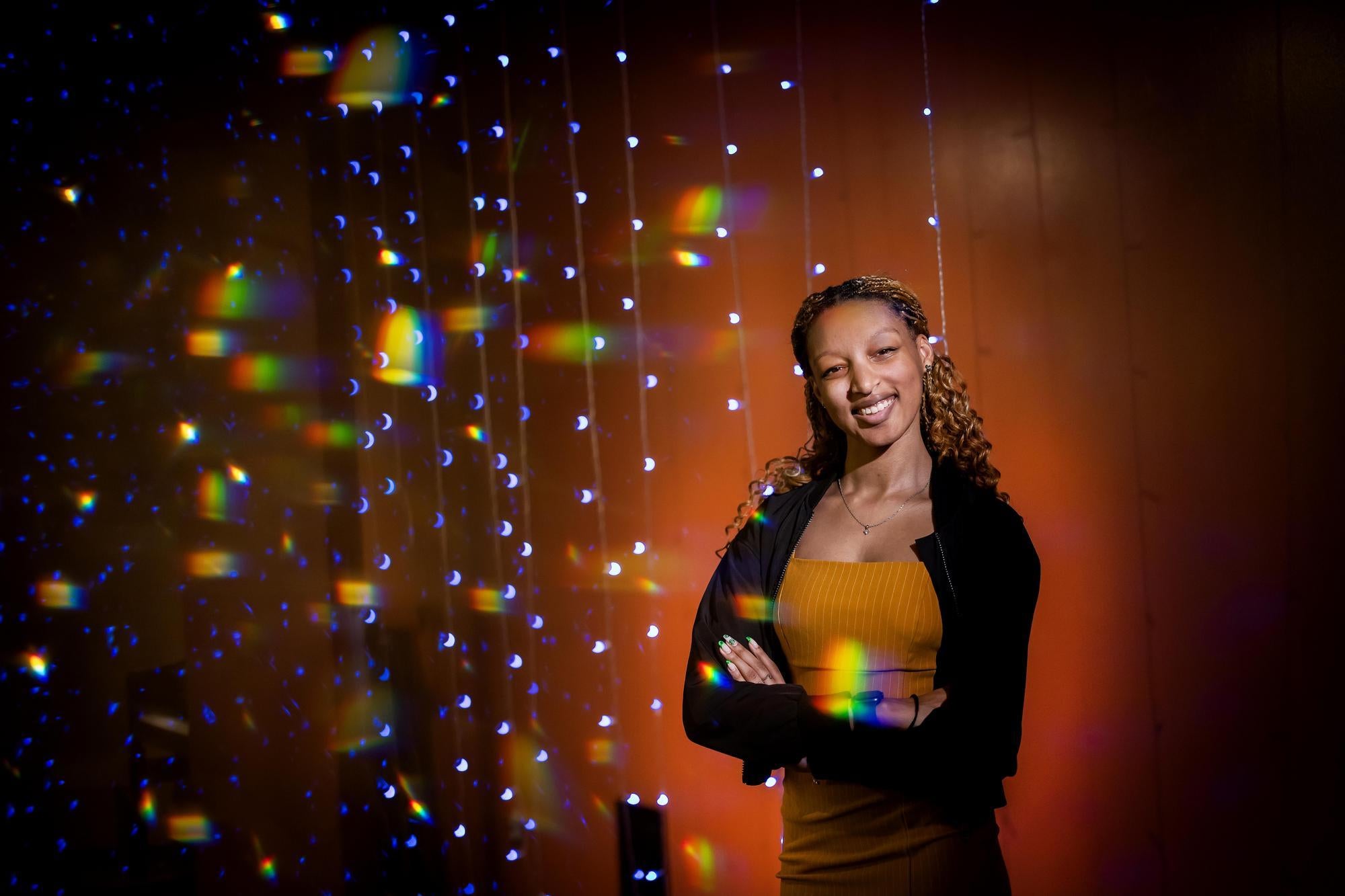This story was originally published on May 13th 2025 in Penn Today.
Writer: Louisa Shepard
Photographer: Eric Sucar; Scott Spitzer
Graduating fourth-year Jordyn Harris is pursuing a career in engineering and medicine while also dedicating herself to the performing arts.
Mixing it up is what graduating fourth-year Jordyn Harris likes best.
At Penn she has been an applied science in biomedical sciences major while also pursuing a major in gender, sexuality, and women’s studies, and she has had a work-study job in performing arts and another job as a researcher at a hospital. Harris has also been on stage as a dancer and behind the scenes running tech for student shows while also volunteering as an adviser and mentor for engineering students and a member of a performing arts senior society, as well as a sorority for women in science, technology, engineering and mathematics (STEM).
“I’m a STEM girl who does performing arts; I like the mix,” Harris says. “I’m always doing something. But I love doing all of the things that I do.”
From Baltimore, Harris will graduate this month with a bachelor’s degree of applied science in biomedical sciences from the School of Engineering and Applied Sciences with a second major in gender, sexuality, and women’s studies from the College of Arts and Sciences.
“I’m doing a little bit of everything, and that’s what I think I’ll do with my career generally,” she says. “I want to dive into STEM and medicine but also performing arts as an outlet for my creative side, being in both, and having them interweave with volunteering.”
Harris helped other students as a volunteer orientation peer advisor and an advisor through the Advanced Women of Women in Engineering Preorientation program.
“The thing that is always surprising about Jordyn is how dedicated she is in terms of what she commits to. There’s a sense of responsibility that she has with every role that she’s taken on,” says Sonya Gwak, who until recently was director of student life and undergraduate education, but now is director of global academic programs at Penn Engineering.
“Jordyn’s information has always been reliable because she’ll do her homework and make sure that what she says is accurate. People can depend on her,” Gwak says, including making sure every first-year student is registered for classes. “Because it’s completely voluntary and it because it is a huge undertaking, having somebody like Jordyn in that role is invaluable.”
Harris encouraged engineering students to do performing arts and clubs and other creative pursuits even if that wasn’t what they planned for their careers. “Finding what makes you you, and doing those things in the midst of your career, in the midst of your academics, is key,” she says.
Performing Arts
Since her first year at Penn, Harris has been a work-study student at the Platt Student Performing Arts House helping to manage programming, as well as scheduling rehearsals and performances for student groups. Her interest in performing arts began with ballet when she was about 4 years old. She continued through high school where she played the violin and piano and also dove into theater arts, on stage and behind the scenes.
“If you don’t directly ask her or see her doing good things on campus, you won’t know because she is very humble,” says Laurie McCall, director of the Platt House, noting the many leadership roles Harris has taken on, including mentoring new students as they navigate their performing arts experience.

Harris won the Platt House Impact Award that goes “to a student who goes above and beyond the scope of their campus responsibilities” to represent student performing arts “through continual service, model leadership, and general goodwill,” McCall says. “She is a joy to have in our circle.”
Since Harris’s second year at Penn she has been behind the scenes for many student performing arts productions, including iNtuitions Experimental Theater and several Theater Arts Council shows.
“I’ve done pretty much all sides of tech: lights, sound, stage managing both theater and dance,” she says. “I’m also producing, making sure everything is managed the way it should be, things are getting done, all the deadlines are met.”
Her third year she joined Onda Latina as a dancer and usually performs salsa but also mambo fusion, hip-hop, and bachata, working with student choreographers.
STEM
While involved in high school theater, she also was taking all the advanced placement science classes. “Growing up I always wanted to be an engineer,” inspired by her father, she says. “I think that sparked me; I’ve always been good at math, so engineering was my way to go.”
She decided she also wanted to study medicine. Harris chose Penn, she says, because of the bioengineering program and the opportunities to volunteer at hospitals.
Harris completed pre-med requisites, including biology, organic chemistry, biochemistry, chemistry, and physics. She also chose bioengineering design courses, learning how to design medical devices. In one class she worked with doctors at the Perelman School of Medicine “learning about the different devices that they’ve created and learning how to build devices around patients.”
She completed most of her bioengineering classes in her first two years and then took gender studies courses in her third and fourth years. “I really like the breadth of gender studies at Penn because every class is different. I learn something new with all of them,” she says.
“I want to be able to apply those into engineering, into medicine: how different cultures, different races, have been influenced throughout history,” she says. “Especially in the medical field, coming at it from both an engineering STEM and a gender studies perspective.”
For nearly a year Harris has been a paid undergraduate student researcher at the Children’s Hospital of Philadelphia (CHOP) working with Jalaj Maheshwari in the Center for Injury Research and Prevention. The prior two years she was an undergraduate student researcher with Michelle Johnson in the Rehabilitation Robotics Lab at the medical school.
Harris’s thesis for her applied science degree incorporates the work she has been doing at CHOP, which involves running computerized car crash test simulations on child car seats, testing parameters and dimensions of the seats to minimize child injuries in crashes. A subproject of hers is developing a program that manufacturers can use in building the car seats, and to make recommendations to parents to maximize safety.
Penn Alumni recently awarded Harris the 2025 Association of Latino Alumni Student Leadership Award from the James Brister Society.
Looking Ahead
This summer, Harris will be continuing her research at CHOP, with goals of publishing a paper and presenting at conferences. She then is planning to take two gap years, to explore abroad, work, volunteer in hospitals and in theater, and apply to medical schools. She is leaning towards a career in orthopedics. “I’m interested in robotics and prosthetics,” she says.
Gwak says Harris will be greatly missed when she graduates since she has been “a constant part of the community” with a “quiet leadership” that “exemplifies building relationships.” At Penn for 32 years, Gwak says Harris is “one of those people that you remember forever. Once you interact with Jordyn, it’s hard to forget her.”
Graduation will be “a bittersweet moment” and no longer being in school is going to be an adjustment, Harris says. “But I’m excited for what the future holds,” she says, adding that she will return to campus to see the student shows. “I’m going to be that alum who comes back.”

